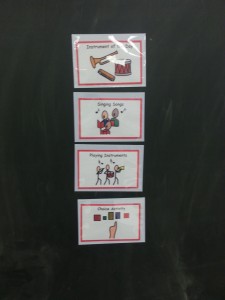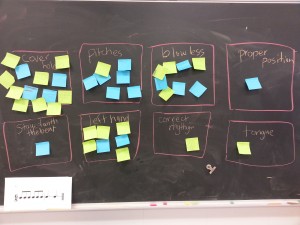I teach music to a contained class of students with autism once a week. On a mission to program effectively for these students, I have been consulting with our team of experts and reading some new resources. Two months into school, this is what my period with them looks like:
An important part of helping students with autism is providing structure to their program. There are no surprises in my class. The order of the day is visually presented on the black board. To prepare the schedule, I bought frame holders that were two for a dollar at the dollar store. Next, with the help of an amazing TA at our school who is a Board Maker whiz, I chose some visuals that will indicate what kind of activities we will be completing in class. The schedule is taken down as we go through each activity.
Next, a challenge for some people with autism is sensory experiences. My class starts with the instrument of the day to allow students the chance to hear, feel and touch a new instrument. So far this year, each student has had the chance to experience and explore with a saxophone, baritone and a snare drum in the “musician’s chair”. Students can feel, hear and see the instrument that they are playing and what kind of sound they can create with the instrument. There have been some minor hesitations on the part of a few students, but with some encouragement and support, all of the students have participated.
Next, we do some songs and instruments playing together as a group. My goal for the beginning part of the year has been to find songs that the students will engage in. Some songs that have been successful are “animal actions”, “jumping in the puddles” and “play and stop” with instruments. Trying to play melodies or specific rhythmic patterns hasn’t happened yet, but we will work towards that. I try to listen really closely to the students during this section of the class and follow their interests and skills. For example, when we were playing instruments recently, one student asked if we could make our playing into a parade. “Yes we can,” was my answer.
Then, to build a reward into the structure of the class, the students have a choice activity at the end of the period. They can choose something arts-related. I usually have drama (costumes), art (drawing or 3D building) or music materials (instruments) for the students to access in their own way. It is a great time to interact with the students while they are taking the lead and showing me their interests. (It has been helpful for gathering ideas for our next class.)
Challenges that I have witnessed include that I have an open classroom with no structural space in it. Whereas in their classroom, there are designated areas for certain tasks, my classroom is very open with few distinctive spaces. Also, transitions can be really difficult for some students with autism, and movement between rooms can be stressful. I have tried to pick an activity that is highly engaging to start every class in order to ease the stress of the transition.
Building relationships with parents is important to every student’s success. I have chosen to build the relationship with parents by sending home a book that we have been creating throughout the term. The book contains a section for each instrument we have played and interacted with. In each section it has a picture of the student playing the instrument, the name of the instrument and a listening response completed by the student. Whether it is high, low, loud or quiet. When the book is sent home right before the break, I will include a note explaining my goals for our music program this year.
Finally, I would recommend two resources to help you understand your students with autism. The first place to go to is the Ministry of Ontario’s resource called “Effective Educational Practices for Students with Autism”. This is a great introduction. Also, an amazing new book “Teaching Music to Students with Autism” by Alice M. Hammel has been very helpful in my experience.
Overheard in my Ontario classroom:
Outside my classroom right now there is a large sign that is a countdown to the arrival of the Canadian Opera Company. The first day my students saw the sign there was a lot of excitement as they came into the room. I was so impressed at how culturally mature they were. We started our class and as they were speaking to each other excitedly, I realized something: they didn’t understand that the opera was coming – they thought that Oprah was coming.






 e kids need a reminder that it is getting too loud. When it gets to just NO – that means there is NO Talking. It took a few times for them to get to the No Talking part to realize they needed to keep it down. I have paired this with an app that shows the decibels of the room so the lunch helpers don’t have to guess, and have just given them an upper range and when the class goes over that limit, take down a letter. I project the app on the screen so the kids can see where they are as well – add a little science to their snack time!
e kids need a reminder that it is getting too loud. When it gets to just NO – that means there is NO Talking. It took a few times for them to get to the No Talking part to realize they needed to keep it down. I have paired this with an app that shows the decibels of the room so the lunch helpers don’t have to guess, and have just given them an upper range and when the class goes over that limit, take down a letter. I project the app on the screen so the kids can see where they are as well – add a little science to their snack time!
